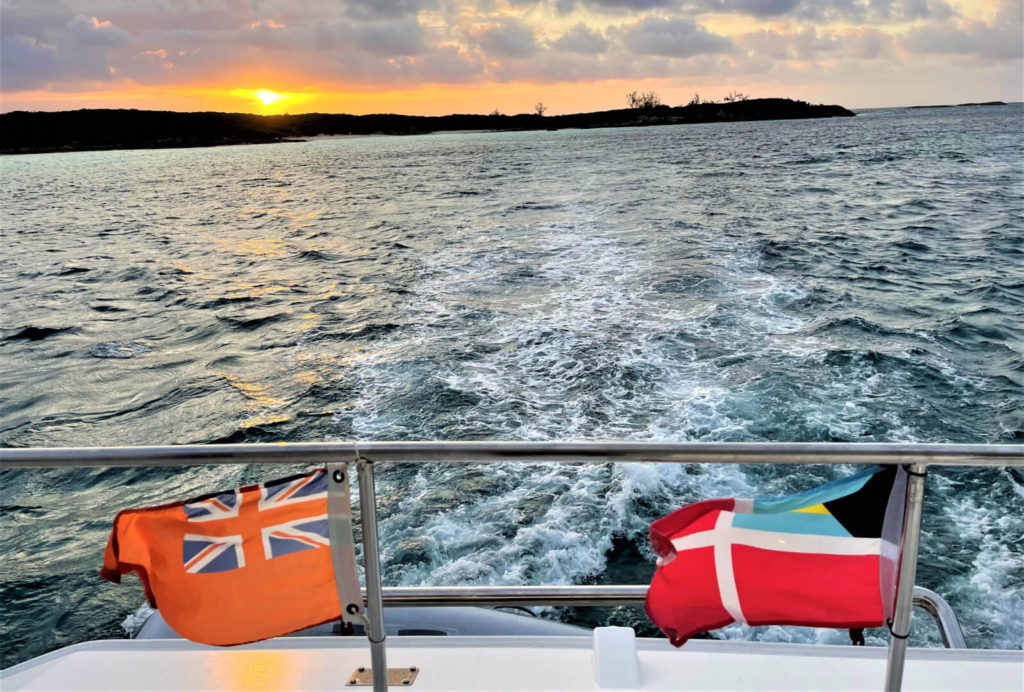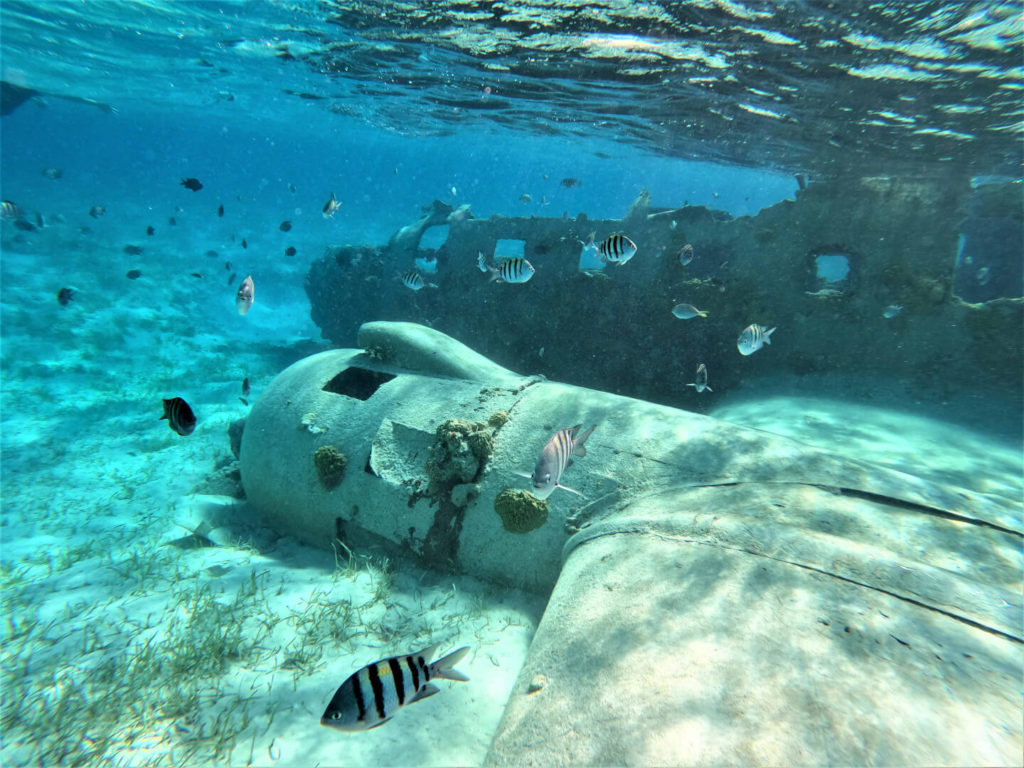
Let’s explore the Exuma Cays that lie north of the Land & Sea Park in this first of a three-part series on bareboat yacht chartering in the Exuma Cays of The Bahamas. This area we cover here includes the following destinations:
This series will follow a route from north to south, but you may follow a different order when building your own itinerary. For a broader overview of bareboat chartering, or just boating in general, in the Exuma Cays, click here.
My focus in this guide is on the more popular things to see and do in the area. Keep in mind that even the most popular spots in the Exuma Cays are still relatively quiet with only a handful of other cruisers or tour boats around. If you are looking for complete solitude and self-discovery, there are islands and spots that I’ve left off my discussion completely (we didn’t go to them, after all). The Exuma Guide by Stephen Pavlidis is an excellent resource for the area with far more detail than you’ll find here. In fact, you might consider gaps between my discussion and Pavlidis’ book as the go to spots for solitude.
Preparing for Your Charter in Nassau, Bahamas
Nassau, on the island of New Providence, is the most populous city in The Bahamas. It will most likely serve as the start of your Exuma Cays yacht charter. Most of the resorts on Nassau are on the north side, on or near Paradise Island (home of Atlantis), about 10 miles from the airport. Palm Cay Marina, where you’ll pick up your charter yacht, is on the south side of the island, 15 miles from the airport and 10 miles from the resorts. So, assume a 20 to 30 minute ride to get anywhere on the island.
Interestingly, despite the 20-30 minute distances, everything in the Bahamas takes 10 minutes if you ask a local. For example, when we checked into our hotel at 1:30pm, they said we were early and the rooms weren’t ready, but have them set up in “about 10 minutes”…we didn’t get into our rooms until 6:30pm! Keep this in mind anytime you need something urgently, and when you don’t, sit back, relax, and have a drink. They served us free drinks and conch fritters at the hotel bar for the 5 hours we waited for our rooms while the bartender explained the 10 minute island time and other island culture.
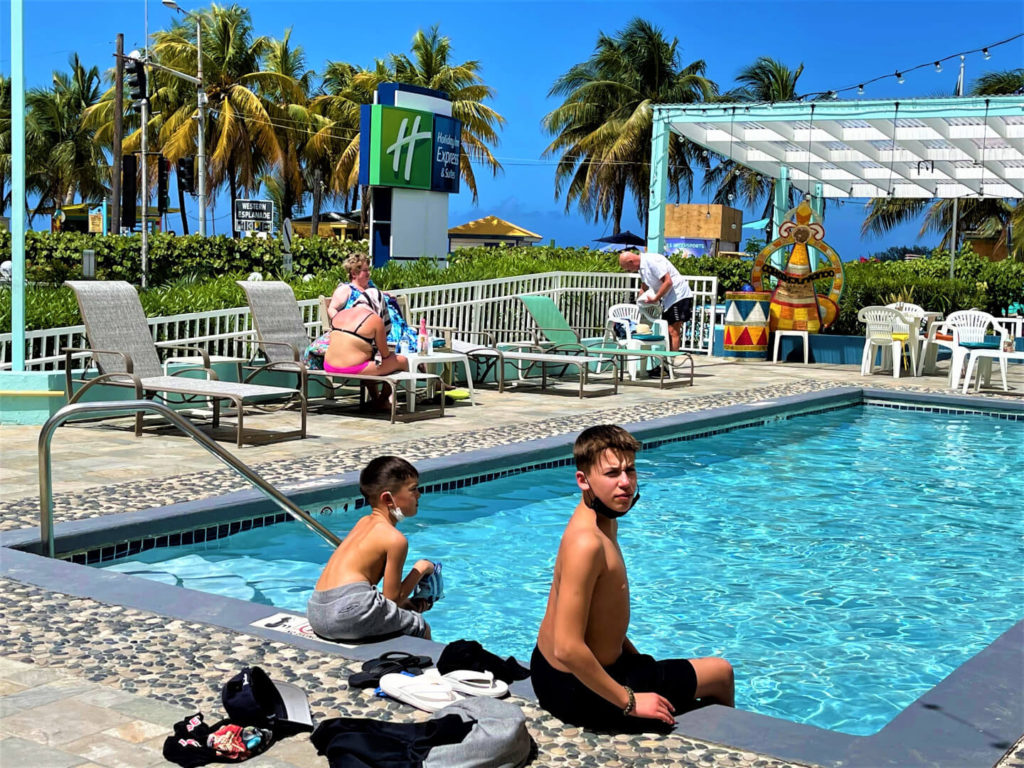
We chose to spend our first night at the Holiday Inn Express on Junkanoo Beach. It was less expensive than options in Palm Cay and gave us an opportunity to experience the largest city in the Bahamas (this place is a dump shithole, in case you were curious). However, your logistics will be easiest if you are able to go directly to Palm Cay Marina upon arrival to Nassau.
There are villas available for rent at the marina, but they have a three night minimum stay requirement. Dream Yacht Charters/Navtours told us that they can arrange for one free night before a charter. However, with Moorings/Sunsail the only practical way to stay in the marina is by arranging to sleep aboard your yacht the night before (for 2/3 the daily rental rate). Some charters start in the afternoon. In those cases, you’ve already effectively arranged for a sleep aboard because you won’t have time to leave the marina and get anywhere before sunset.
Palm Cay Resort and Marina in Nassau
Charters from both major charter companies in Nassau (Moorings/Sunsail and Dream Yacht Charters/Navtours) leave from Palm Cay Marina. There are some one-way charters that start in Georgetown on Great Exuma; which will still end here in Palm Cay. The resort, which includes a resort condo development in addition to the full-service marina, is located on the southeast side of Nassau. This departure point is closer to the Exumas than the marinas on the north side of Nassau. It also positions you well to avoid most of the coral on the Yellow Bank (more on this later).
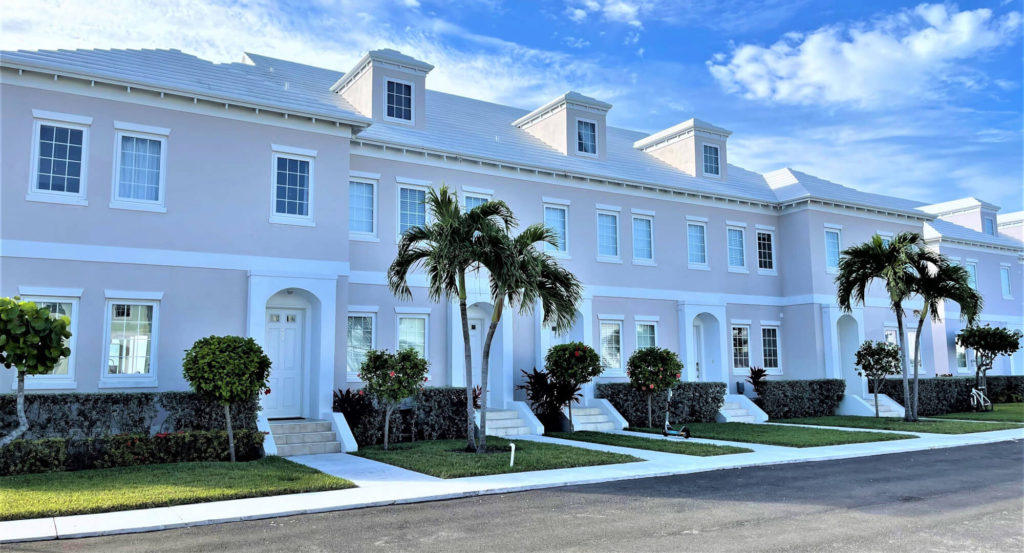
Taxi Service in Nassau
Taxis do not frequent this area of the island. When you are leaving, you’ll either need to get lucky and catch one making a drop-off, call for a taxi, or schedule one ahead of time. We watched one crew wait several hours for a taxi to pick them up for an airport transfer. So we recommend you arrange for a pickup with the taxi that brings you in, especially if you have a tight transfer. Our taxi driver, while not always inexpensive, was early to every scheduled pickup. He also drove a full size Toyota Hiace with seating for about 10 plus plenty of room for luggage. If you have a large crew, look for one of these at the airport.
As mentioned above, our taxi driver charged $175 to pick us up on the north side, drop half the crew of 7 at Palm Cay, then round trip to Solomon’s, including waiting for the grocery shop. We also paid $55 for a ride from the airport to the north side, and another $175 for our final ride from Palm Cay back to the aiport. Taxis in Nassau have meters, but the drivers don’t use them. You can negotiate your price before getting in the cab, or be surprised by the price when you get out (like we were). Having a tax driver whisper a big number in your ear as you exit the cab feels a lot like getting a doctor bill in America several months after you broke your toe, only on a much smaller scale.
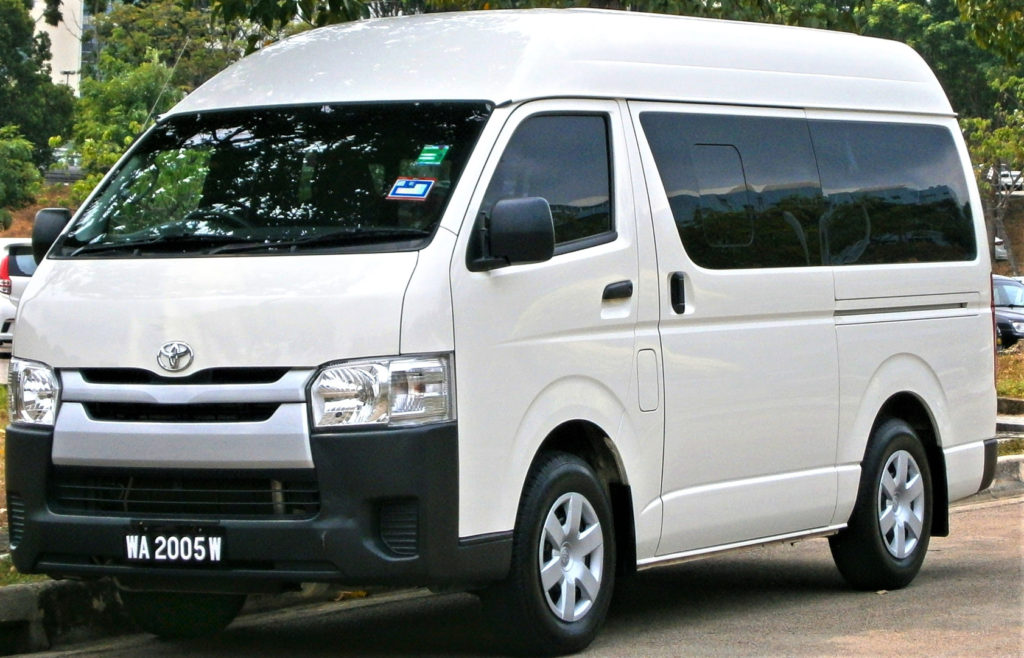
Provisioning at Solomon’s Near Palm Cay
If you combined the pricing of Whole Foods with the selection, ambience, and out of stocks of a 2020 pandemic lockdown era Wal-Mart, you’d have Nassau’s local grocery chain: Solomon’s. There is a Solomon’s one mile up the road from Palm Cay Marina. This is your best bet for provisioning your boat. Buy EVERYTHING you will need for your charter there, plus a little. You’ll find the few small stores in the out islands are significantly more expensive and even more poorly stocked. Bottled drinking water is $2 per gallon at Solomon’s; in the Exumas you can expect to pay $6 per gallon for bottled and $0.50 per gallon for hose water. Don’t rush this part, do sweat the details.
Not only will the selection be different than what you are used to back home, but lots of things will be low or out of stock. Pricing sometimes seems irrational too: 12 packs of La Croix were $15.99 but some other lime flavored fizzy water in liter bottles was $0.99. So prepare to be flexible. Beverages are eye wateringly expensive here, but other items were a bit more reasonable. We found economy in feeding the kids Tang (don’t judge) and getting drunk on liquor instead of beer (judge). They do take credit cards without an extra fee. The staff were very helpful when we sent two beautiful women in to pick a large order.
Are there other options for provisioning? Sort of. Solomon’s Fresh Market on the north side of the island is a more upscale store…with even more upscale prices. This might make sense if you have some very specific needs, although we were able to find plant based milk, and gluten free snacks at the cheaper Solomon’s. While you could take a longer taxi ride to the higher prices, the Fresh Market does offer a provisioning service. However, I’ve read others say to expect to get shorted on 1/3 of your order. So, you’ll still be making a run up to the cheaper Solomon’s either way.
The Moorings has an online provisioning service that offers (crappy) selection and (crappy) pricing that is in line with the out island stores. I would have provisioned beverages from them just to make our shopping trip easier, but the pricing was absurd with bottled water at $6 per gallon (sound familiar). Dream Yacht Charters/Navtours offers a provisioning service of cost plus 15%. Since we spent $645, our charge would have been $97. That would have been cheaper than our $175 taxi ride…however, again, this is one of those “if you want something done right, you gotta do it yourself” kinda deals. So if we chartered with Navtours, I might place an order for some simple things like the water, but still would plan a run up there after confirming my inventory.
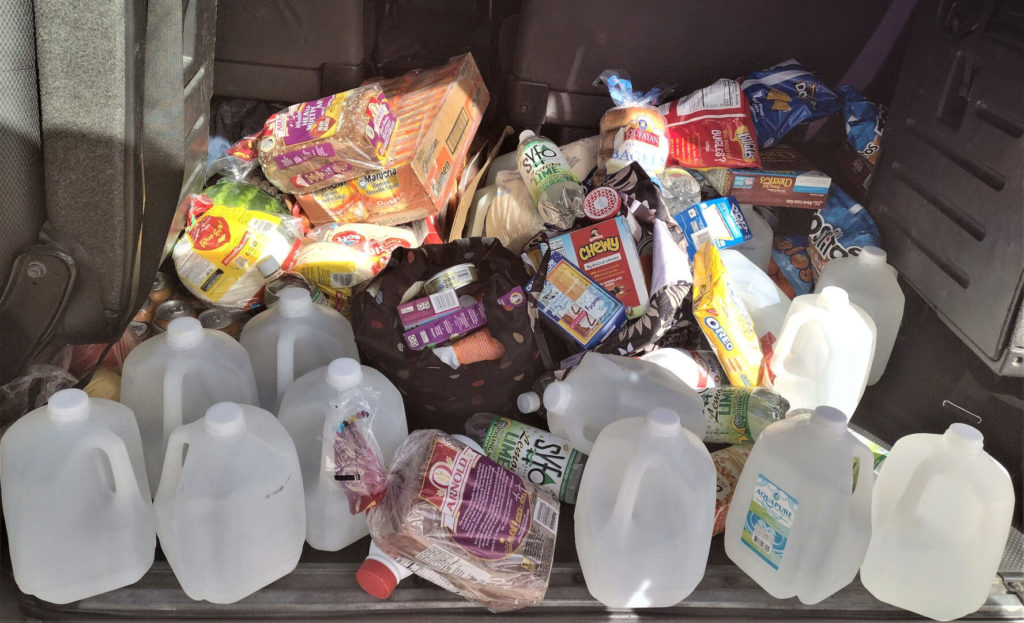
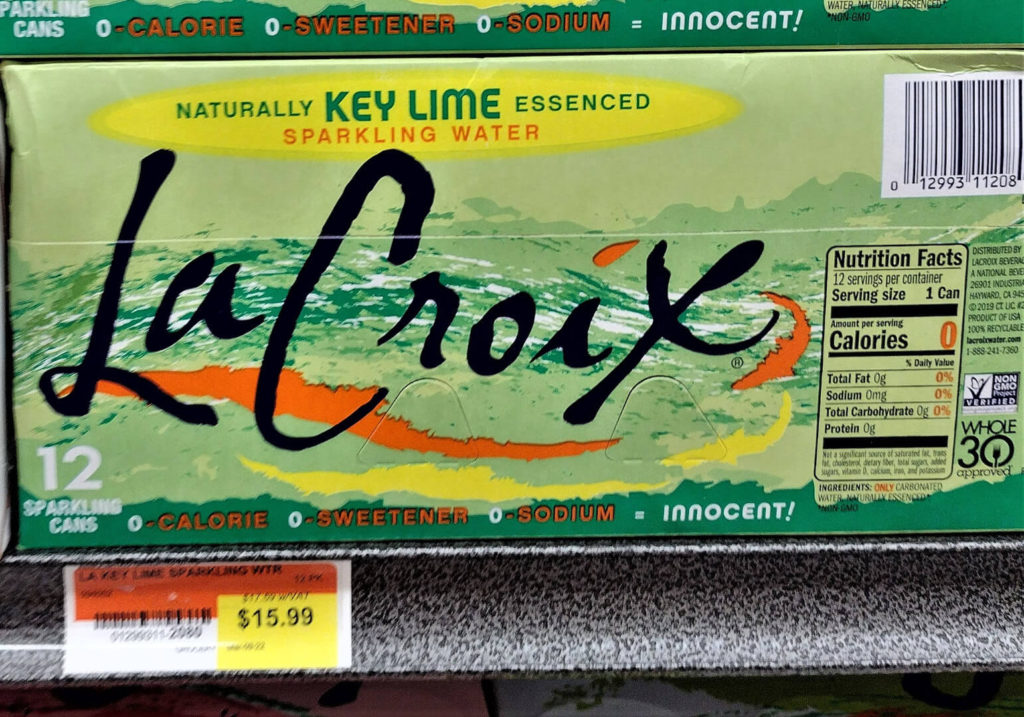
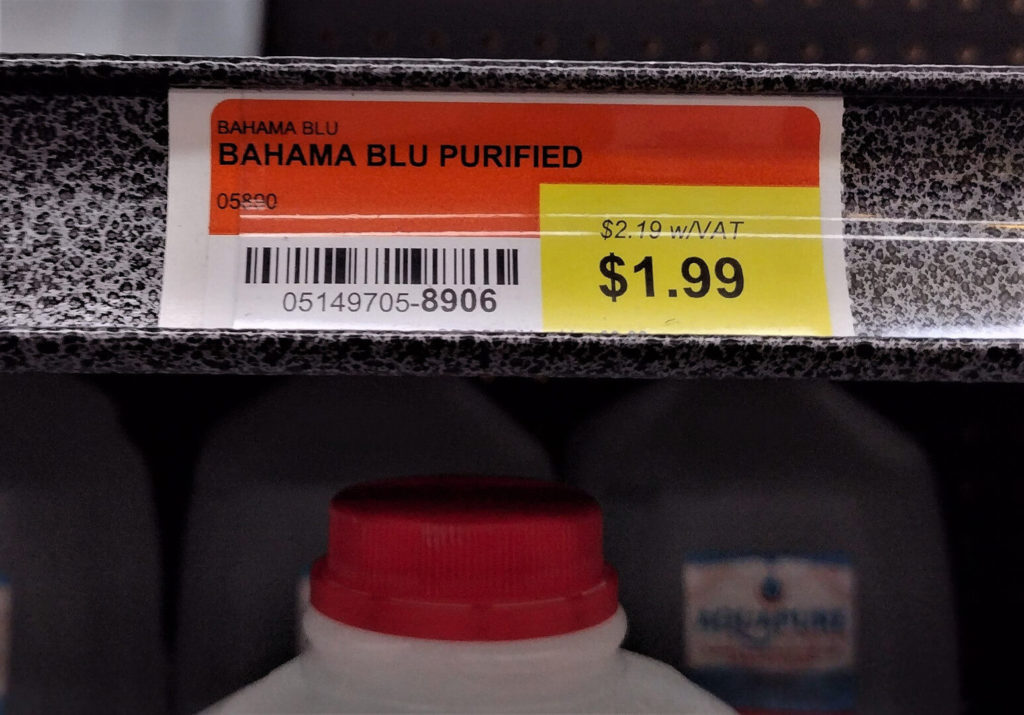
Navigating the Marina at Palm Cay
Palm Cay Marina is relatively tight. The inlet only has room for one boat to maneuver through a tight, coral edged turn in and out. The fuel dock can be tight as there were several large boats moored long term on one end of it. If the dock is full, you’ve got to pass it and idle in another tight spot ahead of it that is exposed to the inlet, so if it is windy, it can be challenging. However, you might have better luck maneuvering into the fuel dock by going up here and turning around so you can have your bow into the wind (that’s what we did).
There is not much space between the slips to maneuver either; although the Navtours/Dream docks are easier than Moorings/Sunsail since they pull straight away from the seawall without any dock fingers. Your checkout skipper will take the boat out of the marina and either tow an extra dinghy to get back or have a dock hand ride out to pick them up. I’m sure you can radio for similar assistance returning if you are uncomfortable.
Leaving the marina, you’ve got to use a dredged channel that makes a sharp turn to port toward another marina entrance, then a quick turn to starboard into a marked and dredged channel that takes you past some shallow coral beds to the Exuma Bank. The water is shallow enough at the end of the channel that you can anchor in this area while waiting to enter the marina because the fuel dock is full, your slip isn’t open yet, or you need a skipper to help bring you in.
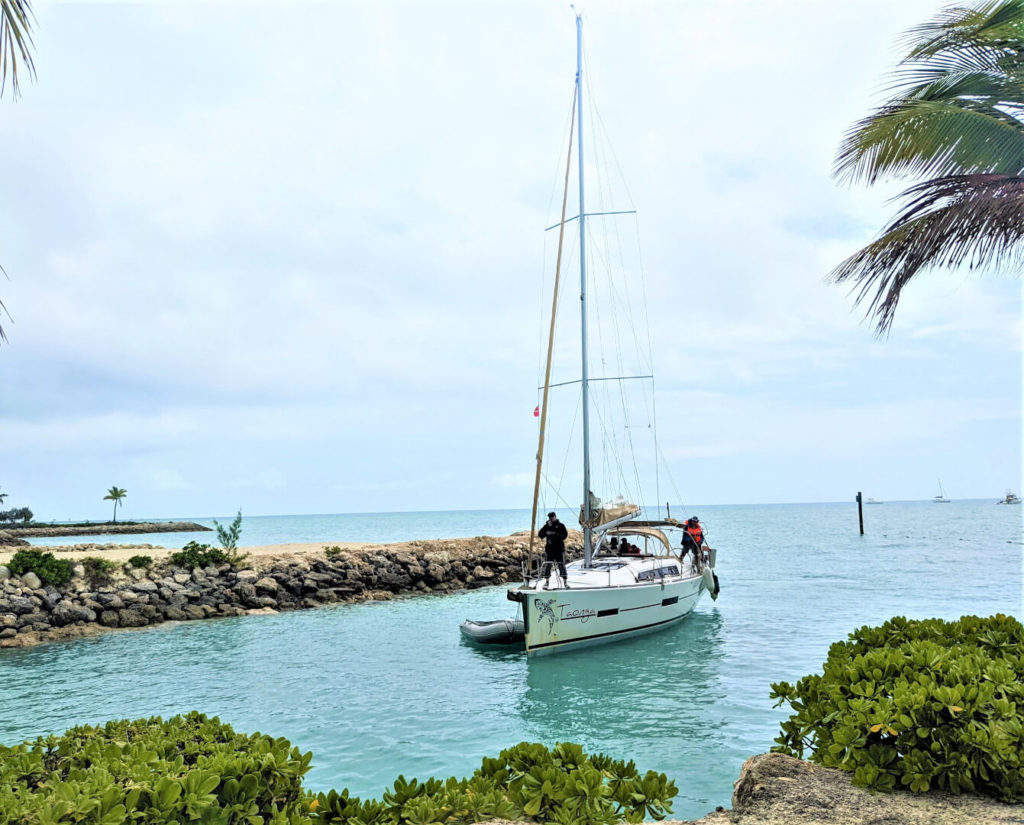
The weather forecast brought us back to Palm Cay a day early. We ended up enjoying our time there. For $10 per adult (children were free) we got wristbands from The Moorings office that allowed us access to the resort facilities: showers, two pools, beach, beach bar and a restaurant.
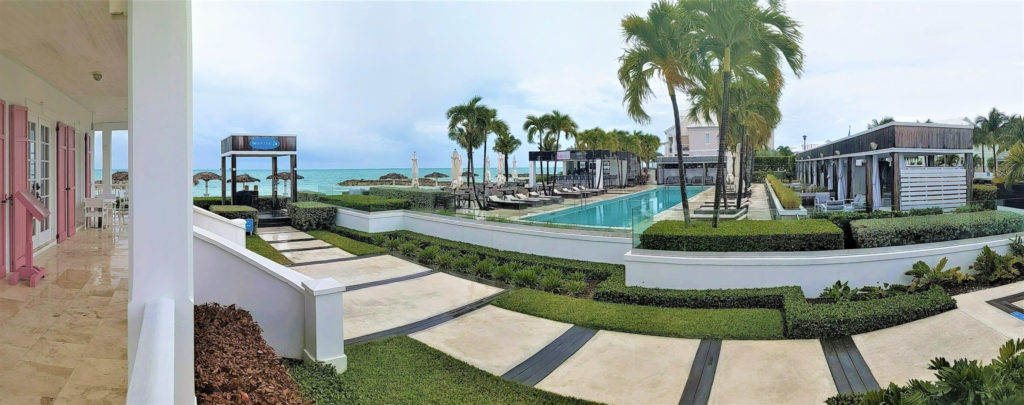
There’s also a coffee shop with light provisions and overpriced t-shirts; you do not need to pay the cover charge to access the coffee shop.
The dock hands at fuel dock will fill your tanks for you and charges a 5% fee for credit cards. Diesel was $5.49/gallon when we were there, which was about what fuel stations back home in Portland, Oregon were charging that week.
The Moorings/Sunsail office is in a little building at the north end of the marina, across from the Moorings/Sunsail boats. The Dream/Navtours office is at the south end, near the fuel dock and resort facilities; however, their boats are moored along the East seawall, so you’ve got to walk the full length of the marina and around to the other side to get from the office to your boat.
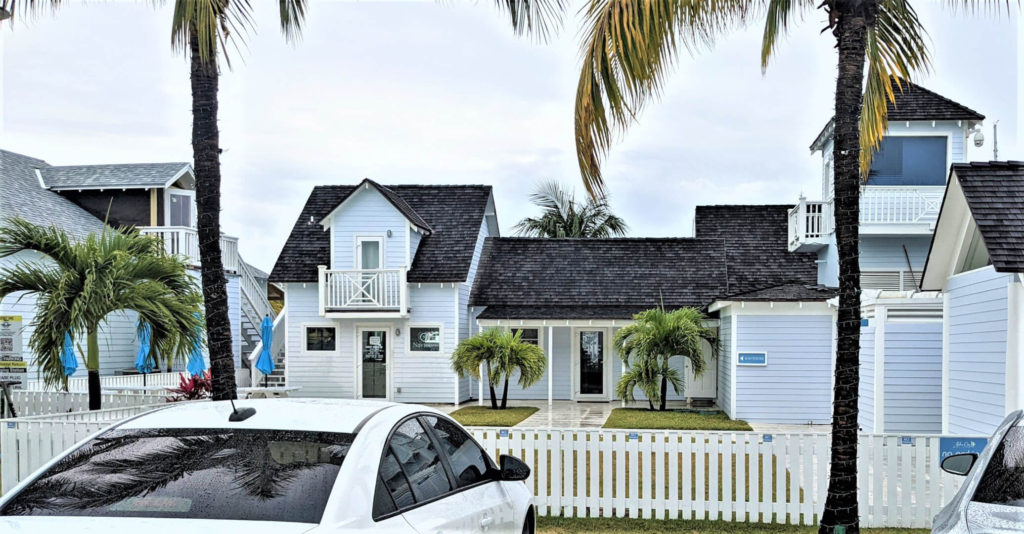
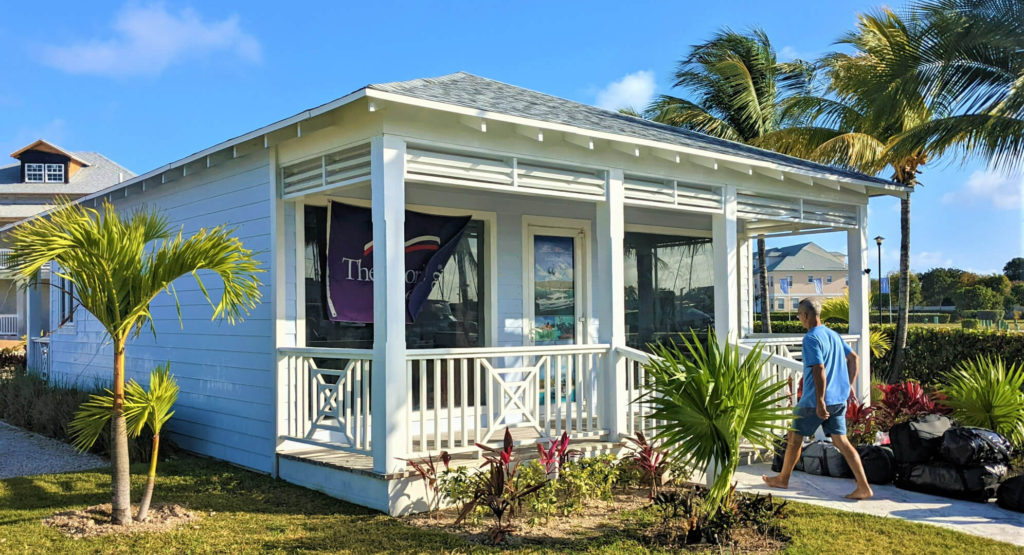
Moorings/Sunsail has boxes on the dock with snorkel fins; be sure to pick some up if you didn’t bring any.
Crossing the Exuma Bank
Navigating Shallow Water
The stretch of shallow water between Nassau and Great Exuma are broadly referred to as the Exuma Bank. From Nassau, you’ll be traveling southeast across this bank toward the Exuma Cays. If you look at a chart, you’ll see that:
- The entire bank is ridiculously shallow, like less than 30 feet at its deepest
- There are some navigational hazards about halfway between Nassau and the islands:
- A large group of little + or * signs on the chart marking coral heads is called the Yellow Bank.
- Just to the west of the Yellow Bank is a shallow area of less than 5 feet called the White Bank.
A course plotted from Palm Cay to Highbourne or Norman’s Cay cuts through the Yellow Bank. Fortunately, this path avoids the densest parts of the Bank. This is the preferred route for most boaters and was recommended by our checkout skipper at The Moorings. The safest course, which might be needed for full draft keels, takes you further west beyond the Yellow and White Banks. In a catamaran or shoal draft monohull this seems overly cautious and adds 8 nautical miles to your journey.
While the coral heads are marked on the chartplotter, all advice says to not count on that being perfectly accurate, although we found it to be very accurate on our routes. Instead, you’ll see dark spots in the water that you should maneuver around, which are the coral heads. Theoretically, the bank is deep enough that the coral will be below your boat, but our checkout skipper said its still good practice to go around them. Polarized brown tinted glasses will reveal the most detail in the Bahamian waters in the Bahamas, so order some stylish Blue Blockers if you don’t already have something that fits the bill. I wear prescription glasses, so ordered some brown tint in the largest frames I could from Zenni for about $60.
Determining how far South to Go on Your First Day in the Exuma Cays
After figuring out how to navigate the banks from Nassau, I was interested in determining how far south I can head directly from Nassau, and how far I can expect to get in a single day. Staniel Cay is the southernmost stop for most charterers. However, you cannot plot a course directly for Staniel Cay, for two reasons:
- The Exuma chain turns to the East as it goes south, so you’d run aground on other islands on a straight course.
- As you approach Norman’s Cay there’s another coral field to the West that you’d have to cross for a more southern route.
So the only practical initial bearings will lead you to Allen’s Cay, Highbourne Cay, Norman’s Cay, or maybe Shroud Cay. If you want to go further south, you’ve got two options:
- Cross a ‘cut’ through the cays into the Exuma Sound, then plot a straight course south to your final destination. The most direct route would be through Highbourne Cut.
- Head toward one of the northern cays, then turn south as you approach them and hug the keys on a somewhat circuitous route to your final destination.
Surviving the Exuma Sound
Cutting through the cays into the Sound can significantly reduce your route distance: Highbourne to Warderick Wells is 20 nautical miles through the sound or 30 along the bank. Taking Highbourne Cut to Staniel Cay reduces that route by 5 nautical miles to 37 when compared to the bank route. However, traveling in the Sound does carry its own disadvantages: the Exuma Cays serve as a breakwater for the Exuma Bank. So the conditions in the Sound can be much rougher than on the bank with more wind and more waves, more like the open ocean, but often with a shorter period between waves. Period is important because a short period between waves will feel much rougher than a long period; you’ll be able to handle much larger wave heights if there is a longer wave period.
The other challenge is the cut itself. The openings between cays that form channels are referred to as cuts. As wind, waves, and tidal currents are funneled between the Sound and the Bank, they can become more violent, especially when meeting opposing forces, like an outgoing tide from the Bank meeting an incoming wind from the Sound.
Since we were still getting comfortable with the boat and the cruising area, we plotted a course for Norman’s, then followed the chain south from there to spend our first night at Big Major Cay. This route avoided the cuts and the Sound altogether. Avoiding the Sound also made it easier for us to stop and find an anchorage at any point if it became apparent, we couldn’t make our destination before sundown or the weather turned ugly. This turned out to be prescient because we ran into a nasty squall on the way down that brought visibility to almost zero and forced us to slow down to idle. This would have been much more hectic in the choppy waters of the Sound.
We went out into the sound once in our 43 foot power cat from Bell Cut at O’Brien’s Cay up to Warderick Cut to save some time and it almost cost me my marriage. When we went, the cut itself was relatively calm and manageable, but once out in the sound, we had some nasty choppy waves that rocked the boat something good and regularly sprayed everyone all the way up on the flybridge. Our son barfed ramen noodles all over the place, the microwave fell off the counter, and the wind ripped some of the flybridge curtains apart.
When crossing back into the bank at Warderick, the waves were rolling into our stern faster than our boat at full throttle (17 knots). As each wave picked up the stern, we surfed it and lost steering control. Fortunately, we had enough power that we could have backed off a wave and the waves were traveling toward the heading we needed. In a slower boat at a cut that required tighter maneuvering, this could have been dangerous and any time saved by crossing into the Sound would have been spent waiting for the sea to settle enough to get us into our anchorage…with a very unhappy crew.
You need good weather, and a competent crew that’s comfortable in rough water, to help you make a successful passage into, through, and out of the Sound. Don life jackets before you get near the cut, and if you have any doubts, or are asking yourself ‘how bad could it possibly be?’, STICK TO THE BANK!
Keep in mind as you depart Nassau that the waters will tend to start rough and get calmer as you approach the cays. This is for the same reason that the Sound is rougher than the bank: the cays are breaking the weather, so the further you are form them, the more the wind has a chance to rebuild the waves. So the closer you can get to the cays without being too shallow, the better the ride will be.
Pro tip: Be sure to open your shitters as soon as you are three miles out from Nassau. There are no blackwater pumpouts in Palm Cay or the Exuma Cays, so if you don’t open the drain valves on your way out of Nassau, you are placing a bet that the last charterers remembered to dump on their way in, and it didn’t get refilled when overnighting at the dock, or trying to unclog.
Allen’s Cay
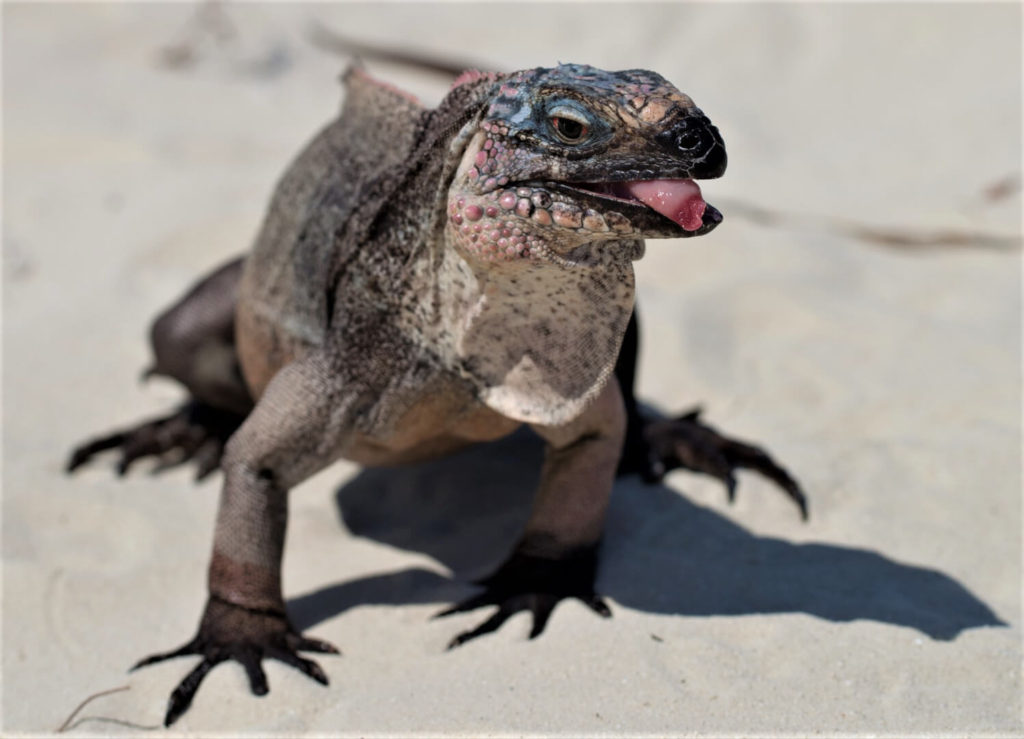
Allen’s Cay lies just north of Highbourne Cay. For cruisers, Allen’s is the northern boundary of the Exuma Cays. Beyond here is a private resort and some shallow coral surrounding a few small uninhabited islands.
Allen’s Cay is inhabited by a mess of rock iguanas that congregate on the beach to greet boaters (expecting to be fed). We skipped this stop on our trip because most of our crew was either fearful of the iguanas or indifferent about the whole thing. If your crew is into this sort of thing, its an easy jaunt over from Highbourne Cay.
When determining where to anchor here, note that the iguanas are actually on southwest Allen’s Cay and Leaf Cay. Southwest Allen’s has a bay with some room to anchor, but there is more space and protection between Allen’s and Leaf Cay. Regardless, the anchorages are tight and see a lot of current, so be prepared to turn around and head south to Highbourne Cay if you run into challenges navigating the area or setting your anchor. You can always take the dinghy back over after getting settled. This is especially true if you just picked up your charter in Nassau and the crew is still getting comfortable with the boat.
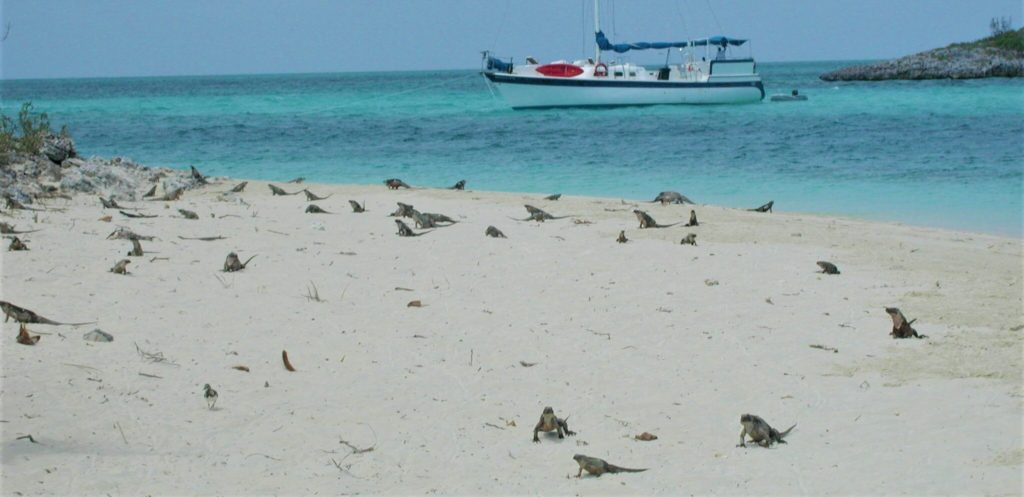
The Bahamas National Trust asks that cruisers not feed wild animals in the Exumas, but recognizes that feeding the iguanas at Allen’s is a popular pastime that will continue. If you choose to feed the iguanas, you’ll want something you can put on a stick to avoid getting bit. I’ve heard of boaters feeding them hot dogs, but these iguanas are herbivores so grapes would be a healthier alternative.
Highbourne Cay
Highbourne Cay is many sailors first stop after making the crossing. Highbourne is a very developed resort and marina. They have fuel, water, docks, emergency only provisions, overpriced t-shirts, and a very nice restaurant.
Anchoring at Highbourne Cay
There’s a very well protected marina where you can pay for a dock if your into that sort of thing. We prefer the zero cost of anchoring as well as the additional solitude. At least here in The Bahamas (where anchoring is easy) on an unfamiliar boat, we also find anchoring less stressful than docking.
Most boats anchor on the west side of Highbourne. If you do this, you’ve got a long dinghy ride in from a crowded anchorage and a shitty view of the cell tower (the good news is cell service is great here).

We chose to anchor just inside Highbourne Cut. It is marked as an anchorage with ‘fair’ holding on Explorer charts. So be mindful of the weather if you head here because it has some exposure to the Sound if the wind is blowing from the southwest.
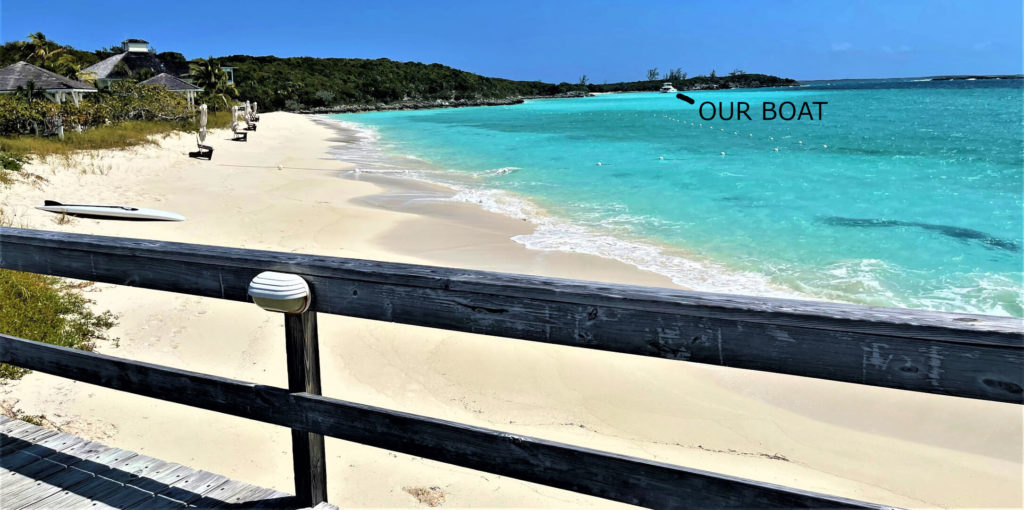
We asked ashore about overnight anchoring here, and the dockmaster said it was fine, but important that you have good holding because if wind from the south or west drags your anchor, you’ll be into the rocks. On the bright side, its a beautiful anchorage, the beach is closed, and, until other boats see someone brave enough to anchor their, you’ll have the place all to yourself.
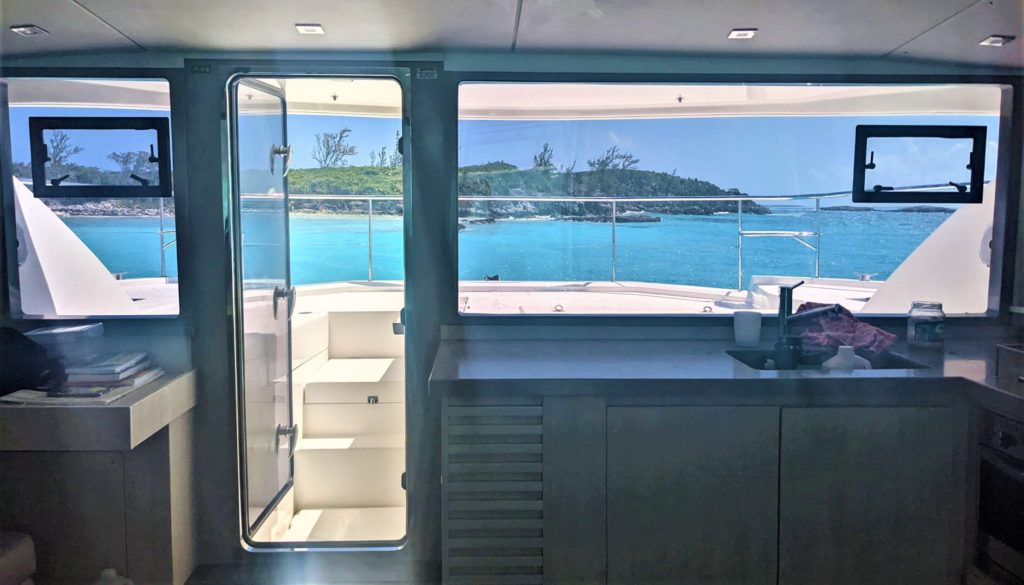
There’s a steep dropoff a few hundred yards from the rocky shore, so we tried to get as close as possible to the ledge to give us some buffer from the shore if we swung during the night. The bottom was nice deep sand with quite a bit of grass. So we dropped the anchor with plenty of scope, then put it in a nice hard reverse to make sure the anchor was good and set. We put on snorkel gear to double check our work: we could see that the delta anchor plowed up a few feet of grass until it was deep and firm. We also confirmed that we didn’t have so much scope that the boat could swing into the rocks or the shallow beach.
Provisioning at Highbourne Cay
The Highbourne Cay marina has fuel and water. Fuel prices are regulated in the Bahamas, so your eyes won’t pop out any more here than they will back home when you fill the diesel tanks. As a practice on any boat, we fill up every time we arrive at a marina with a fuel dock. This gives us an accurate read of our fuel consumption, and increases our reserves in case something doesn’t go as planned.
Water, in the Exuma Cays is a whole different ball of wax. Because the water has to be desalinized with reverse osmosis systems (just like the watermaker that may be on your boat) it ain’t cheap. Hose water at the dock was $0.50 per gallon. If you have some combination of a water frugal crew and a properly functioning watermaker, you might want to skip filling up your water here. If you need to top off your ice, you can do that here for $6.00 for a large 10lb bag.
We found the store at Highbourne pretty well stocked with dry goods, bait, and fishing tackle. The refrigerated and produce sections were pretty meager. While the overpriced souvenirs had price tags on them, none of the food had a price on the shelf. If you have to ask, you’ll probably regret not having bought it in Nassau. They do have ice cream novelties ($4/ea), which is a nice treat after a few days on the boat.
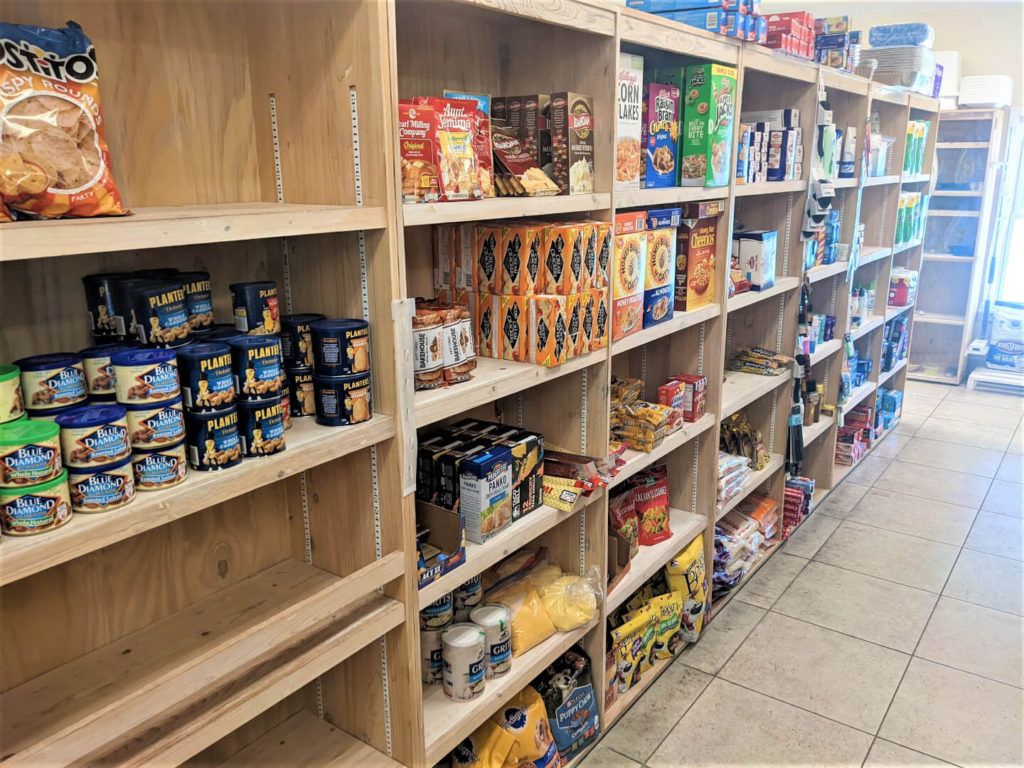
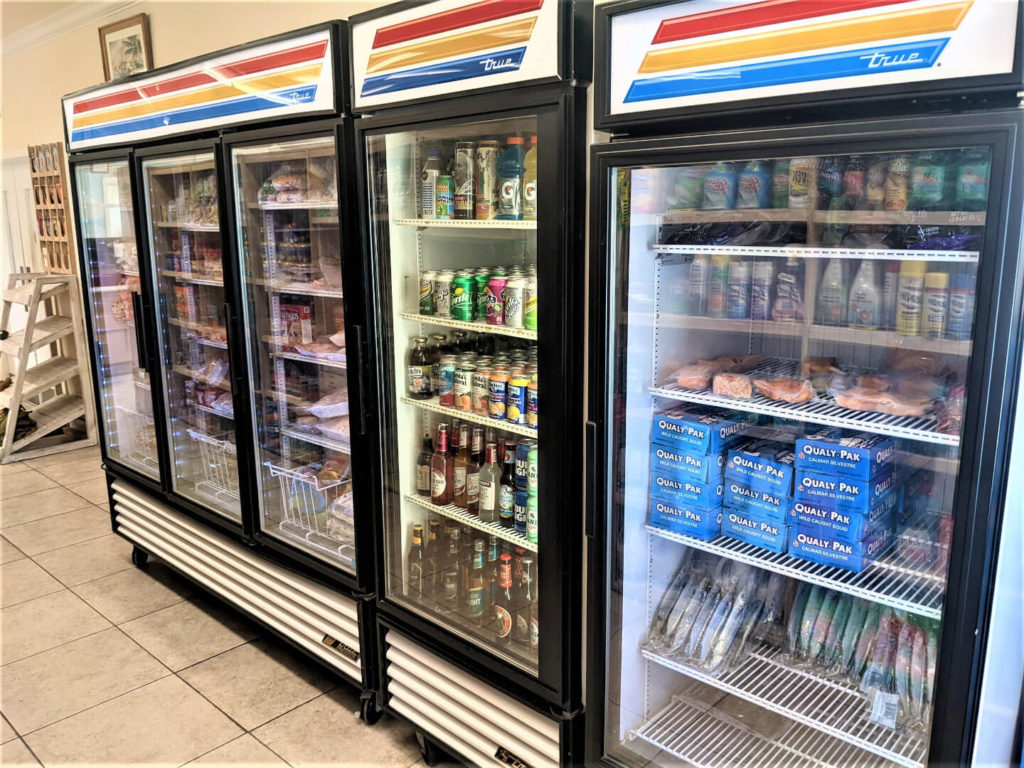
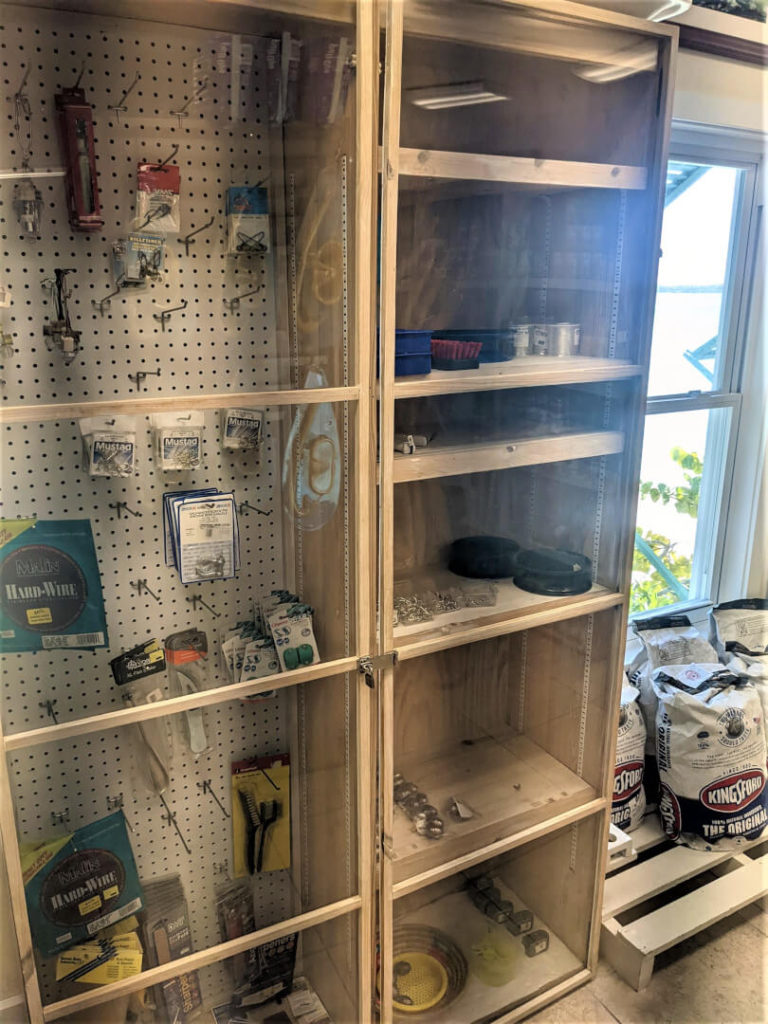
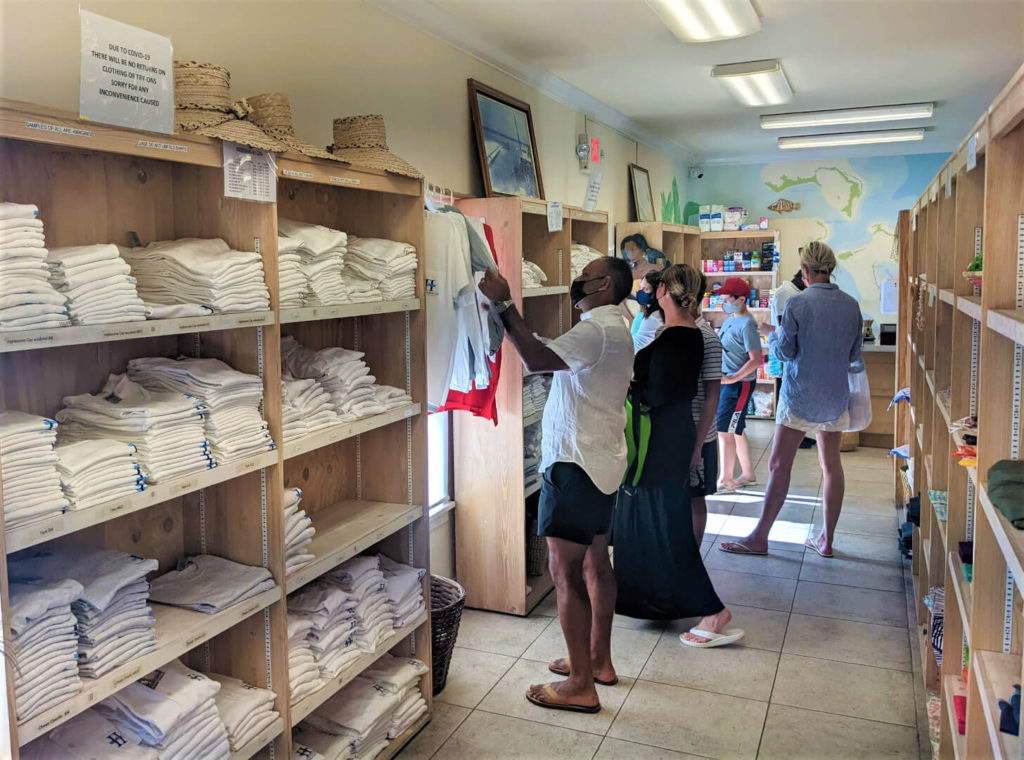
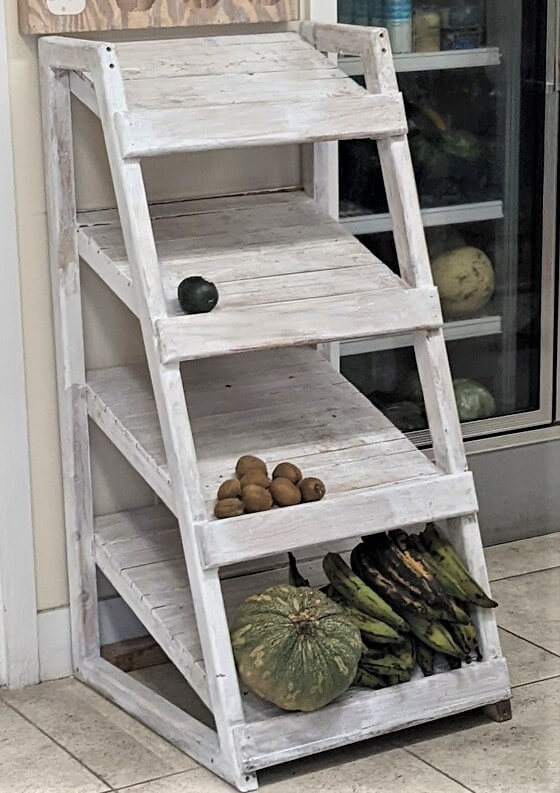
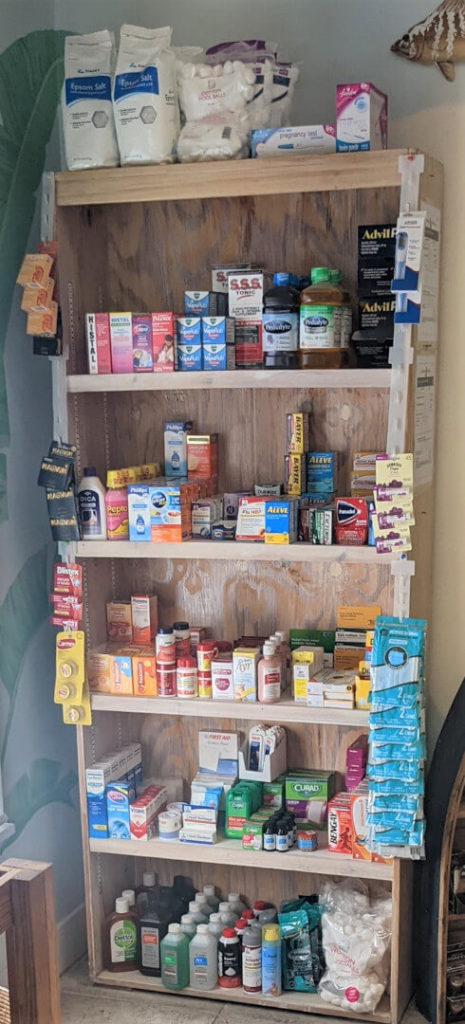
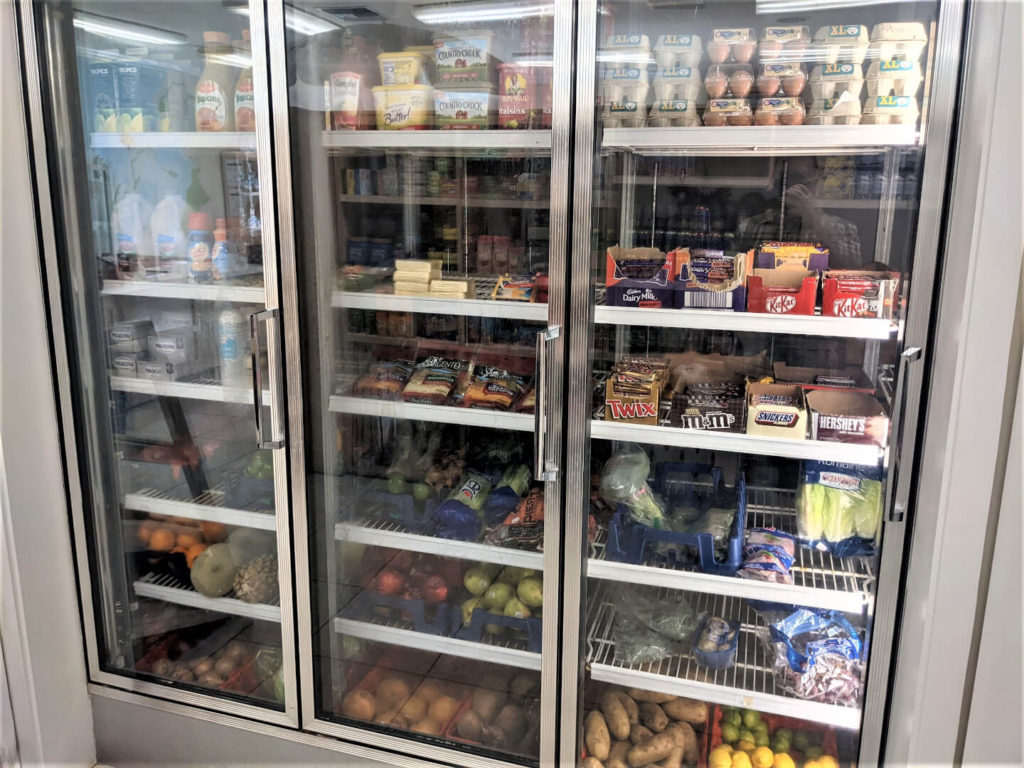
Activities at Highbourne Cay
Highbourne Cay is a private island owned by the resort. As such, the resort allows boaters to come ashore at the dinghy dock in the marina (in the SW corner), but not at the beaches. Boaters are welcome in the marina, at the store, and at the restaurant. To go beyond this area, you must purchase a day pass for $25 per person. The day pass allows you access to the entire island which has several beaches, a playground, walking trails, and gazebos with barbecues. There are also bicycles so you can ride along the trails between the beaches.
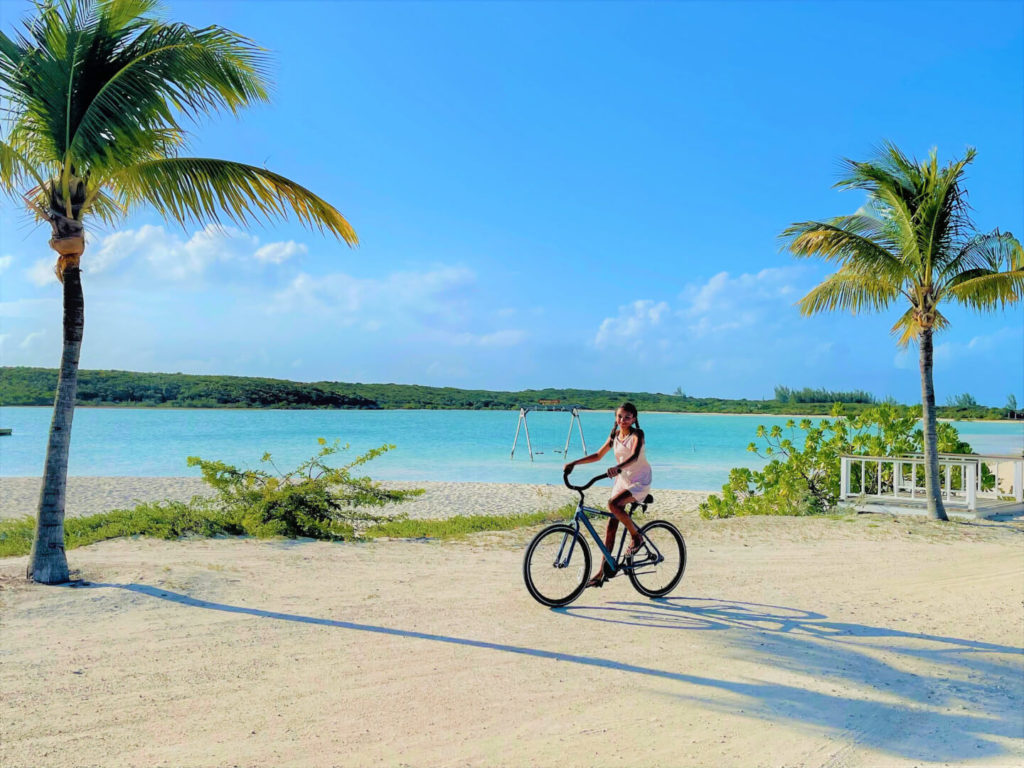
There is a school of nurse sharks here that congregate around the fish cleaning station. However, the dockmaster told us there is a bull shark that likes to join them, so swimming is not recommended. Apparently bull sharks have attacked humans, although it is uncommon, especially in clear waters like you find here in the Exuma Cays.
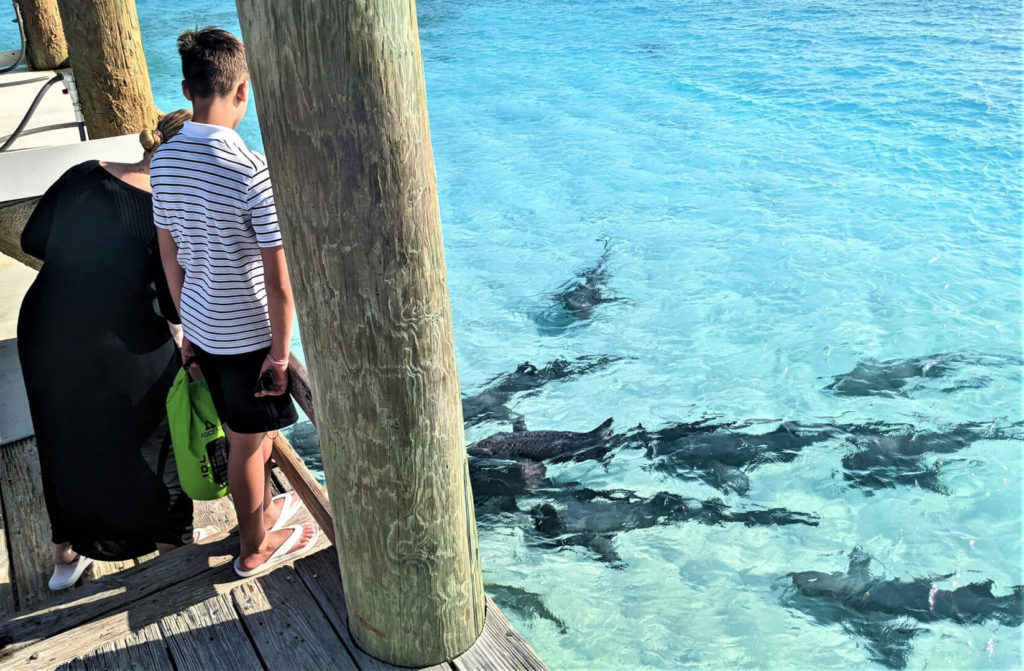
Highbourne Cay has done a great job documenting snorkeling spots around the island here.
Xuma Restaurant at Highbourne Cay
I’d characterize the restaurant here, called Xuma, as high end steakhouse fare. Like most restaurants in the Exumas, reservations are required. We had trouble with internet access on the way in, but were able to wander over to the maitre d’ when we arrived and book a table. The restaurant is terraced so every table has a great view of the sunset. The food was great, and priced as you’d expect for a high end steakhouse back home (at least in West Coast US).
Like many places in the Bahamas, they will bring/charge you for bottled water unless you specifically ask for free water in the form of “courtesy water”, or “a pitcher of water”. While the water in Nassau tastes gross, most of the out islands, including Highbourne, have to desalinize sea water using a reverse osmosis system, which produces top notch drinking water. So don’t waste money or plastic on bottled water.
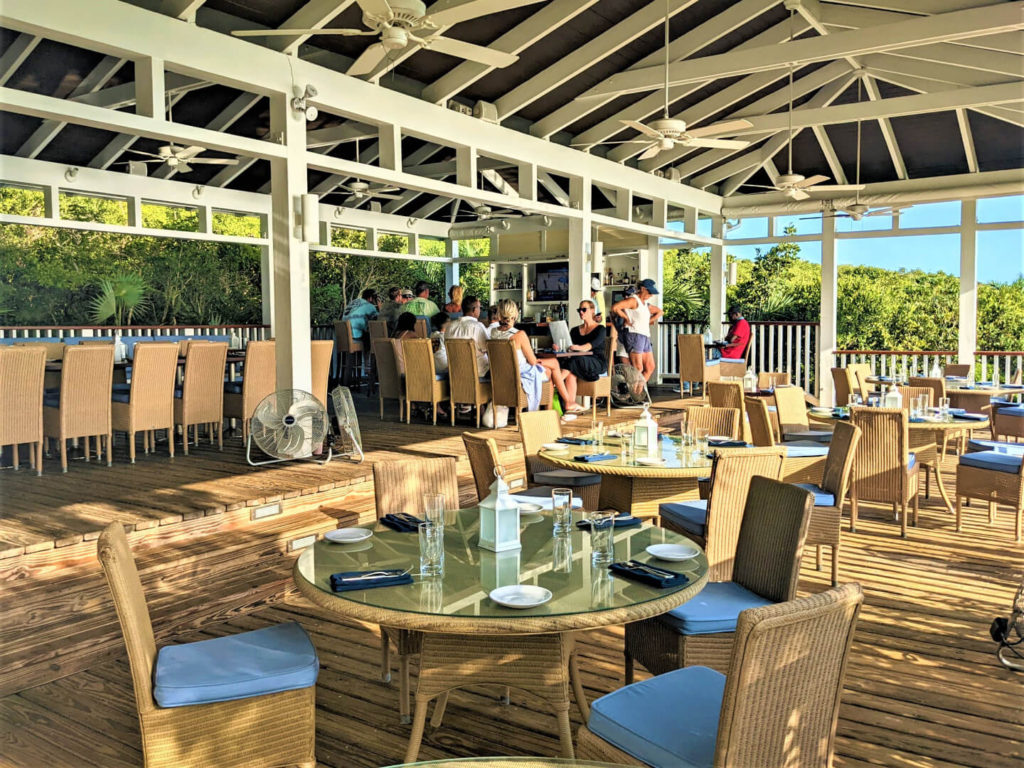
Staying at Highbourne Cay Resort
If you aren’t interested in chartering your own yacht in the Exuma Cays, Highbourne rents vacation cottages. I would not be disappointed in the least to spend a week on this beautiful island. It is a very well-maintained high-end resort. You can still scratch that itch to get out on the water while staying at the resort as fishing charters and tour boats are available in the marina.
Norman’s Cay
Norman’s Cay was the staging area for 80% of the United State’s cocaine supply in the 1970’s and 1980’s. A gentleman named Carlos Lehder improved and extended the runway on the south end of the island and built a swinging pad to make memories at the north end. The airstrip is still operational and serves private jets bringing guests to megayachts that are moored in the newly built marina nearby.
We really enjoyed the low key feel of this island. We aren’t big on talking to strangers, but this was so remote, we did strike up several conversations with characters at the bar, on the beach, and in the water here. In addition to spinning a few yarns about the island’s interesting history, we learned about some of the folks rolling through on much bigger boats than ours. We also met a traveling bartender. If you dream of wandering around shirtless in the tropics with a Yeti backpack full of rum and cokes, and you like brushing the sand out of poodle hair, this could be the career for you. If you dream of sitting in the ocean on a pool noodle and having a shirtless gentleman wade out with a fresh crystal tumbler of ice cold rum and Coke, you’ll probably need a different career.
While there is a restaurant and a marina on Normans, as of 2022 there were no stores (provisioning), fuel, or water services for boaters. Note, however, that there is a lot of development currently going on this island, so the quiet, low key feel may be fleeting.
It is possible to plot a course directly to Normans from Palm cay. This is about as far south as you can practically sail in a straight line from Nassau. Once you get here, you can turn and continue heading south, or drop anchor.
Anchoring at Norman’s Cay
There is a large anchorage toward the south end of the west side of the island, near Macduffs restaurant and the airport, both of which are marked on charts. The beach has a steep dropoff. Depending on your draft, you can anchor very close to the shore. Its a pretty cool place to sit on the bow of your boat and see and hear private jets taking off and landing from the runway that cocaine built. It’s also nice to anchor close to MacDuff’s if you plan to go to shore to eat at the restaurant: you’ll want to wear the nicest outfit you packed, and not get it too wet on the dinghy ride. Since my only collared shirt was cotton, I put it in a dry bag and rode ashore topless…sorry those photos have been lost.

The anchorage is very protected from currents, but, as we learned, you do need to be very careful about dragging in this anchorage, because there is a shoal between the island and the anchorage…also watch out for the shoal arrival as you’ll need to approach from the north or south.
There were a number of boats that anchored in the island’s lagoon, near the plane wreck. It’s a little more challening to navigate in here, and a long, rough dinghy ride to dinner at MacDuffs
Macduff’s Restaurant at Norman’s Cay
Macduff’s is a resort at the south end of the island, just east of the airport. In addition to vacation cottages, they host boaters at their restaurant. The restaurant is not on the beach, but hidden in a grove of palm trees. When approaching in your dinghy, look for the white cottage and grass roofed gazebo pictured below, then walk up the planked path to the restaurant.
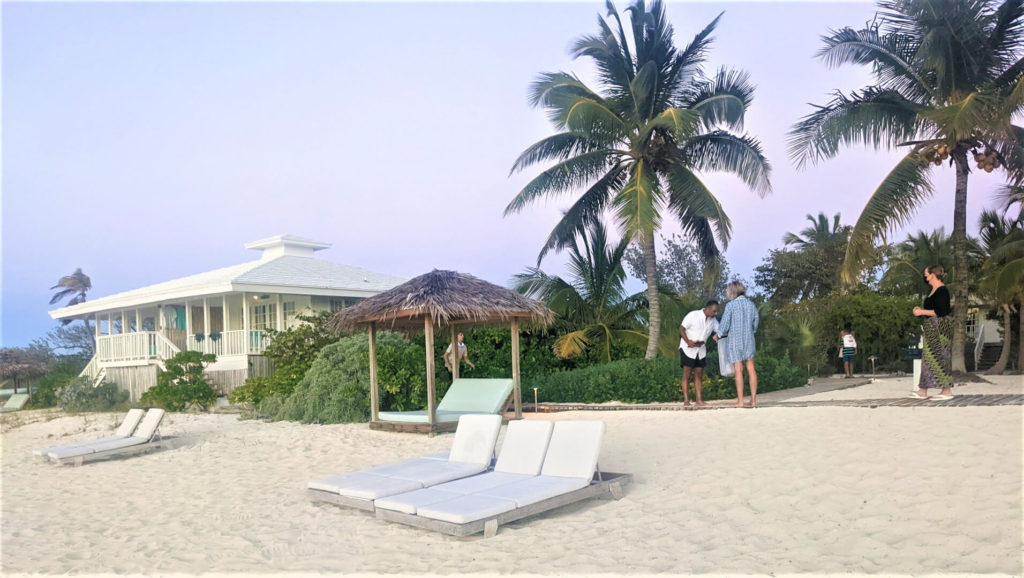
This resort was also very well maintained, like Highbourne, but felt a bit more, for lack of a better word, authentic. Where Highbourne was polished, this felt a bit more rustic. Between the two, if I had a week to spend at the resort, I’d probably spend it here. If you are looking for peace and quiet, there is certainly a lot less bustle here…except for the sound and smell of private jets with the runway just across the street.
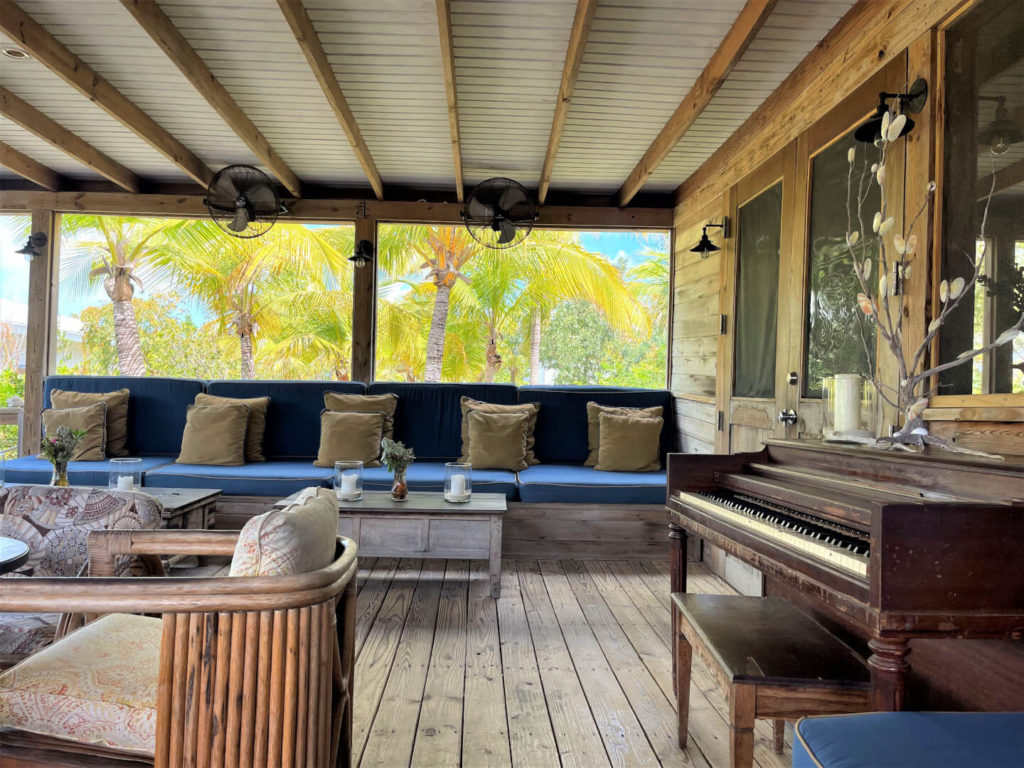
The staff here was far more hospitable to boaters than Highbourne. The restaurant itself was the best and worst of our trip. We went for lunch at noon and had the porch all to ourselves, with very helpful, polite service. Our waitress was generous with information about the island and set us up with a dinner reservation. We sat down at the bar for dinner at 7:30 and ordered drinks, but were never able to order a second round or dinner before the kitchen closed at 9! However, we had a great time chatting with the other boaters at the bar. #IslandTime #IslandLife #NoWorries
The food itself was very good, but the menu choices were not very inspiring. It was charming, and typical for the Bahamas that the server started out by saying “the only things we don’t have today are…” They were out of Pineapple Juice, which was a key ingredient in almost all of their cocktails. Since they don’t post a menu online, and it doesn’t seem seasonal, I’ll leave you a copy below:
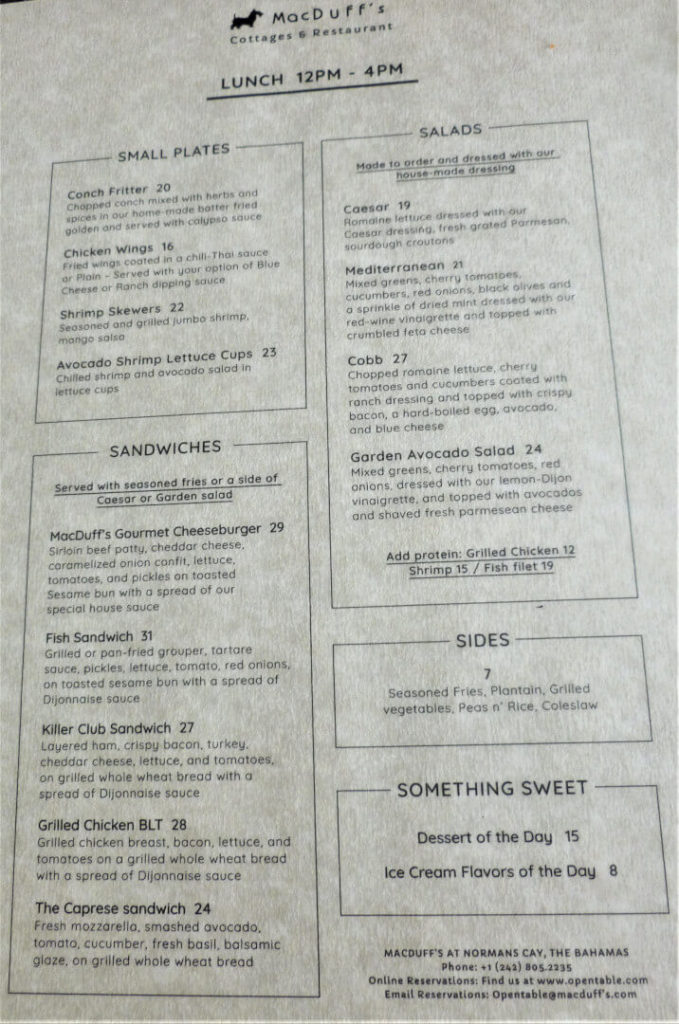
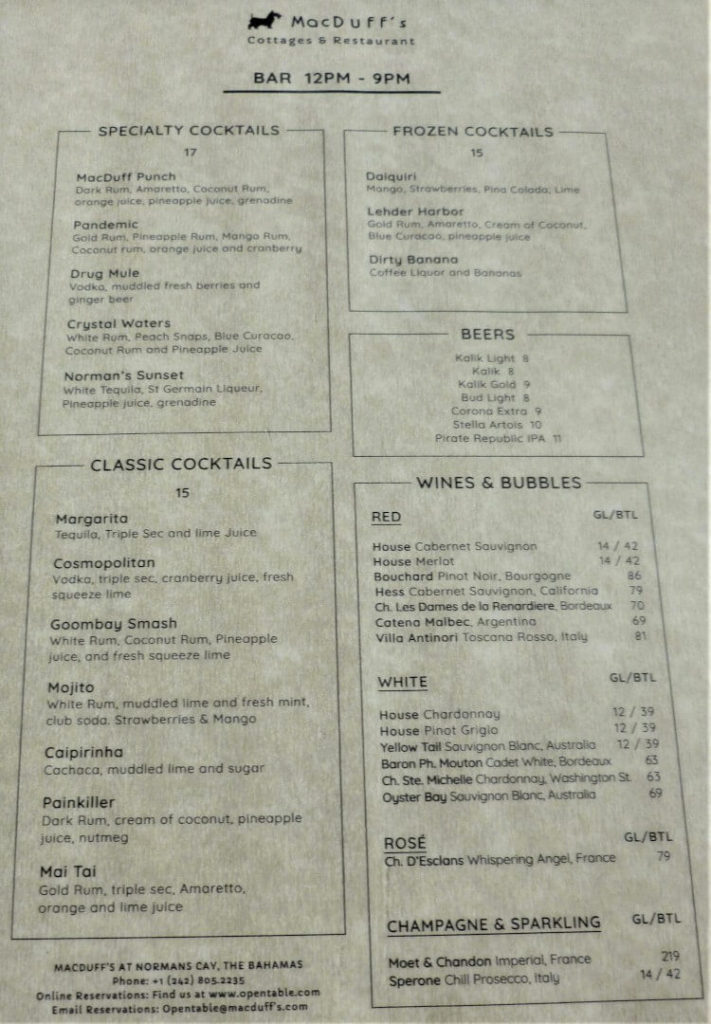
The restaurant has a guest book so you can leave notes about your voyage for posterity. Our kids enjoyed writing in it as much as we enjoyed reading what they wrote.
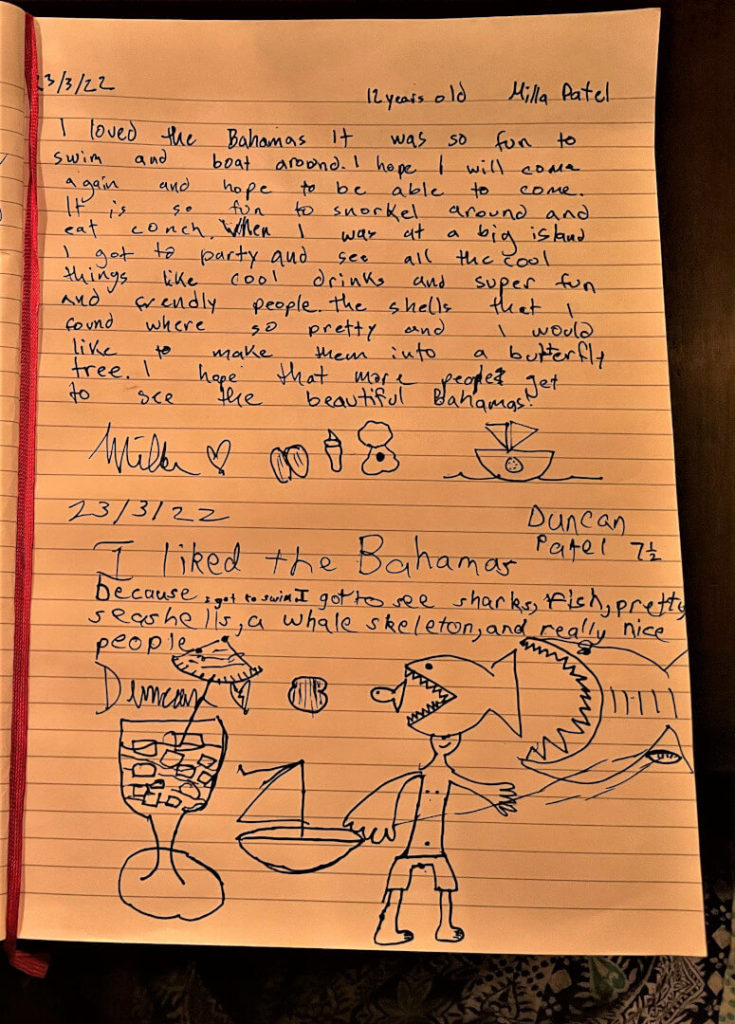
MacDuff’s Beach Bar at Norman’s Cay
Macduff’s maintains a bar on the beach a few hundred yards south of the restaurant. At lunch, the waitress told us the bar was closed but that we were welcome to use the beach. We were delighted to find the beach empty, save for a set of cushioned chairs and umbrellas. Be sure to pack a cocktail kit in your dinghy JIC.
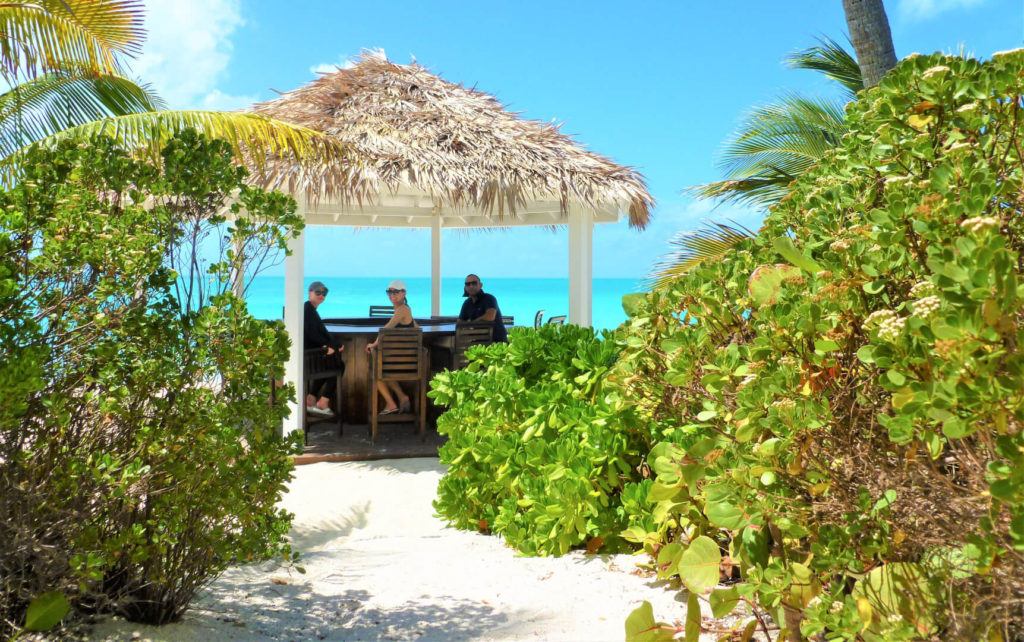
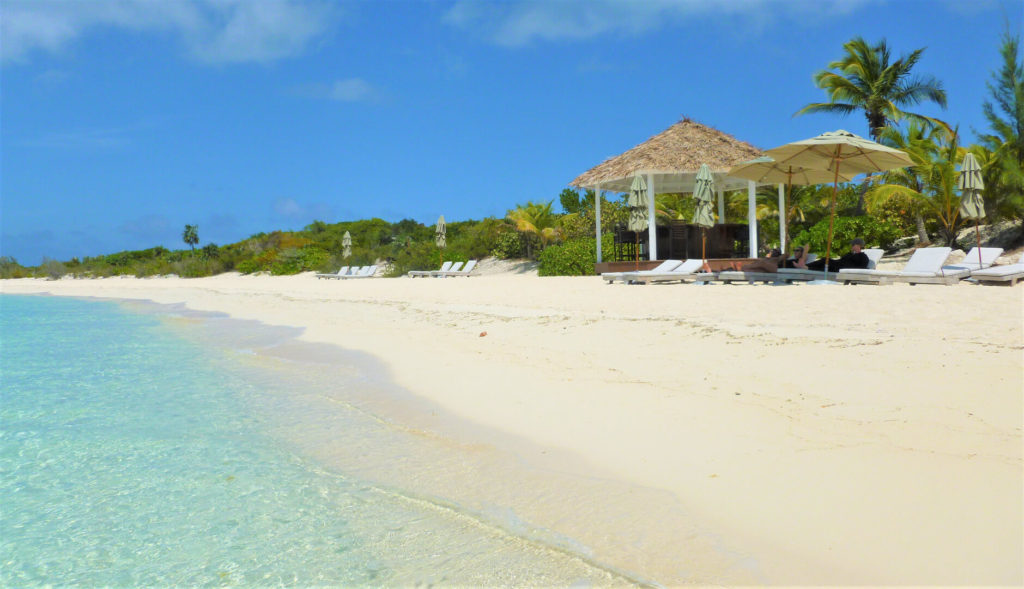
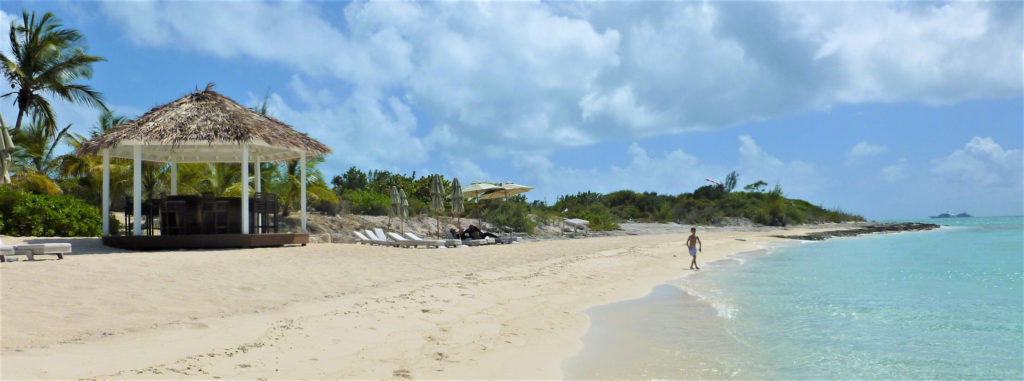
Plane Wreck at Norman’s Cay
In the water, just short of the runway near Norman’s Cay is a wrecked C-46 Commando transport plane. Evidence of cocaine fueled Carlos Lehder era. The plane landed in an area shallow enough that a large portion of the wreck was exposed at low tide. After over forty years of tides, most of the upper sections of the hull have corroded away. However, just beneath the water lies a very accessible wreck. At low tide, you can stand on the port (left) wing with your head above water. There are several other plane wrecks in the Exumas, but this is the most famous and (I believe) the largest.
We took a dinghy over here from our anchorage on the other side of the island at MacDuffs, but you can anchor within 100 yards of the plane on a yacht. Since you have to go around the southern tip of the island to get here, the dinghy ride does get a bit rough as you get exposed to the wind and chop from the Exuma Sound. If your dinghy will be overloaded, I recommend moving your yacht closer.
Plan on arriving at the wreck near low tide. This will give you two advantages: no current to fight, and the wreck will be closer to the surface. This may be obvious, but since the plane is submerged, you can’t see it from your dinghy. We forgot to bring a GPS and realized at some point that we might have no way to find the wreck. Fortunately, there were enough other boats snorkeling in the area and we just headed toward them.
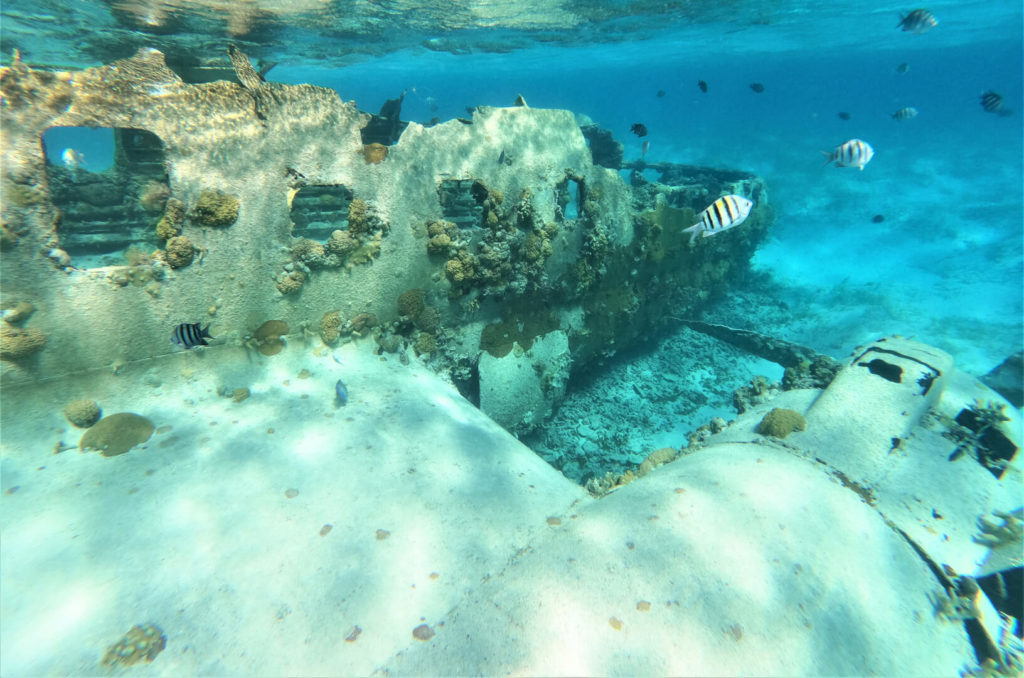
Freediving for Fish on Norman’s Cay
In addition to snorkeling the plane wreck, Norman’s Cay is your last opportunity to fish, collect or harvest before continuing south into the protected Exuma Cays Land & Sea Park. The anchorage in front of MacDuff’s did not seem to be a productive area for marine life. Heading to the north end of the shallow lagoon inside the island would likely yield some opportunities to find lobster and conch as well as look for shells. However, it can be challenging to get there because the south end is so shallow that you may need to go outside the island into the sound to get up there. You’ll find a more accessible site at the north end of the island in the west side (near Carlos Lehder’s house) where there are several shallow coral formations marked on charts.
If you’ve chartered a boat in the Bahamas, you don’t need a license for fishing. If you find conch, you can just pick them up from the sea floor. Catching spiny lobster will require some gloves, a net, and a “tickle stick”. Our local dive shop said the simplest way to make a tickle stick is to bend a metal coat hanger. You can watch video to learn how to catch lobsters here. We never found any lobster or conch outside the park, save for one disgusting rotten old conch shell, but we also didn’t look that hard.
Carlos Lehder’s Cocaine Compound at Norman’s Cay
Before leaving Norman’s, we headed up to the other end of the island to see the ruins of Carlos Lehder’s compound. The compound isn’t actually on Norman’s Cay; it is on a separate island just beyond the northern tip of Norman’s called Saddle Cay. We were told at MacDuff’s that it was okay to go ashore and wander the ruins. However, there were plenty of no trespassing signs all over it. Given that Mr. Lehder was released from prison a few years ago, we obliged. Look for the white house with the ‘volcano roof’ set into the hillside.
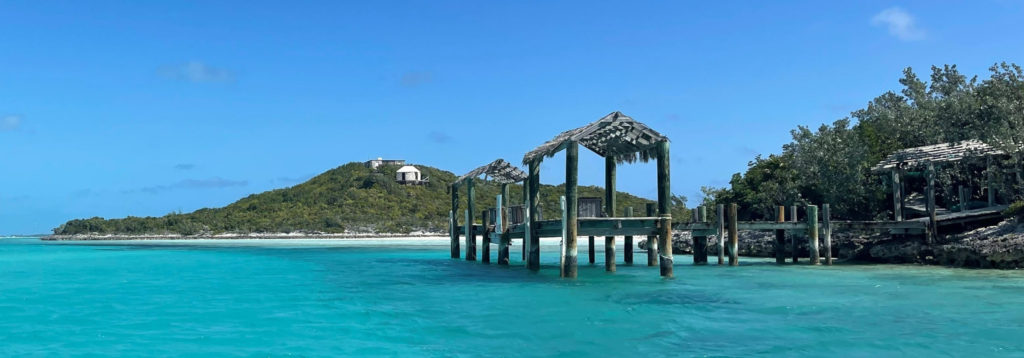
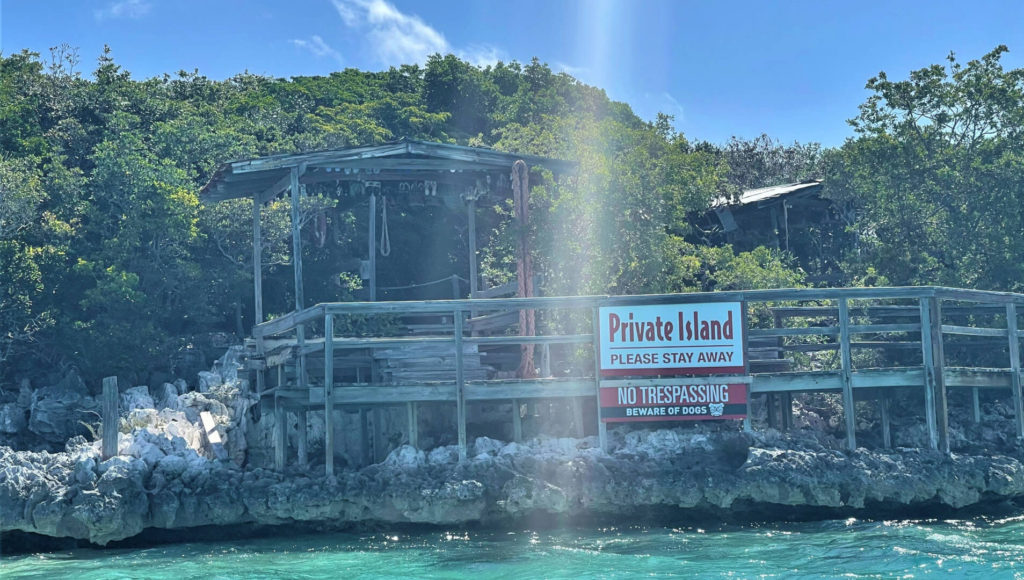
Traveling south from Norman’s Cay will lead you into the Exuma Cays Land and Sea Park. You can read about our experience in the park here. Also, be sure to read our overview of the Exuma Cays here.
